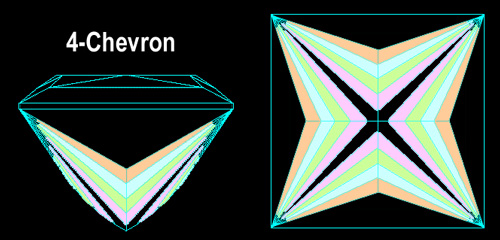How Are Diamonds Made? Natural vs Lab-Created Explained
Two Paths, One Diamond Not all diamonds come from the same place — but they all start the same way. Pure carbon, crystalized under immense pressure and heat. Whether it…
Princess Cut Diamonds – Basics
The princess cut diamond is a great choice for those who appreciate the qualities of a round brilliant but prefer the square shape.
PriceScope Pointers: Most laboratories issue NO CUT GRADE for shapes other than round: If the cut is described as “Ideal” or “Excellent” (etc.) it’s a seller’s description, not a laboratory judgment. Be advised that, due to different cutting styles, a princess cut diamond can have between 24-40 facets on the pavilion.
Before going on: Check out the PriceScope Diamond Buying Guide
Princess Cut Diamond Described
Among the various diamond shapes, the princess cut diamond is a semi-mixed cut, dominated by the brilliant faceting style. The kite shaped facets on its bottom, or pavilion, break up light in a manner similar to the round brilliant cut. When cut for great light performance a princess cut diamond ring can give off brightness, contrast and scintillation which rivals round brilliant diamond rings, but will typically have less visible fire (spectral colors caused by dispersion).

The Fancy, Inconvenient Truth
Cutters will typically produce a princess cut diamond to have heavier weight, at the expense of beauty. This is because many grading laboratories, including GIA, do not assess the optical performance for the princess cut diamond or other fancy shapes. With no standards enforced, manufacturers tend to plan for the highest yield possible, resulting in most princess cut diamonds having large table facets, shallow crowns and considerable depth concealing weight in the body.
Exceptions
The AGS and GCAL assess and grade the optical performance of certain fancy shapes. If you’re seeking cut quality affirmation, fancy shapes with performance deficits will not earn the highest marks from those top-tier laboratories
Princess Cut Diamond Selection Tips
Length to Width Ratio
For a nicely square princess cut diamond a ratio of 1.0 – 1.05 is optimal.
Durability Caution
When considering a princess cut diamond be aware that durability is a concern, since most have pointed corners. Typically, a princess cut diamond ring will be set with prongs covering and protecting those corners. Sometimes cutters will put small flat facets on the corners called “chamfers” providing additional protection against chipping. This makes the setter’s skill a matter of extreme importance when considering any princess cut diamond ring. When properly set, a princess cut diamond is durable for daily wear.
Other Notes
A princess cut diamond looks great in a variety of settings, but to ensure longevity, the corners of the princess cut diamond should be protected with prongs or a bezel setting.
A princess cut diamond will generally look smaller from the “face up” position than round diamonds of the same weight. This is a result of their different designs and the need for ample depth to produce attractive light performance.
Dimensions can be a little deceiving since princess cut diamonds are measured side to side rather than point to point. Generally, a well cut 1ct princess cut diamond will measure approximately 5.5 mm side to side vs. a well cut 1ct round brilliant, which will typically measure approximately 6.4mm in diameter: Another way to look at it is that in order for a princess cut diamond to have a similar visual size to a 6.5mm round brilliant diamond, it needs to be about 5.75mm square.
A Matter of Chevrons
There can be dramatic differences in the way one princess cut diamond performs, compared to another, based on the number of facets on the bottom, or pavilion of the princess cut diamond.
Visibly Different Performance
2 chevron pavilions have 24 pavilion facets

3 chevron pavilions have 32 pavilion facets

4 chevron pavilions have 40 pavilion facets

Logically, light striking a 4 chevron pavilion will be broken up notably more than light striking a 2 chevron pavilion. All other things being equal, and presuming good light performance is present, a 4 chevron princess cut diamond will seem to have smaller, faster dispersion and scintillation events compared to the larger, slower dispersion and scintillation events seen with a 2 chevron princess cut diamond, especially as the light source gets more intense. How much difference you see ultimately depends on overall configuration, the lighting scheme, the distance the viewer is from the diamond and the size of the diamond.
Size Matters

The larger the diamond, the greater justification for more facets so the surface area is broken up proportionately. For example, a 10 carat princess cut diamond (or any shape) needs more facets than a 1 carat princess cut diamond, if the viewer is to see similar optical results. To that end, melee sizes benefit from less chevrons, whereas large weights benefit from more. The most common configurations have 3 or 4 chevrons.
Princess Cut Diamond Prices
PriceScope has been maintaining princess cut diamond prices chart since 2017 and you can visit princess cut diamond prices for the latest retail princess cut diamond price statistics.
Get fast answers to any question: Ask our community of unbiased independent helpers.
Ready to find your diamond?